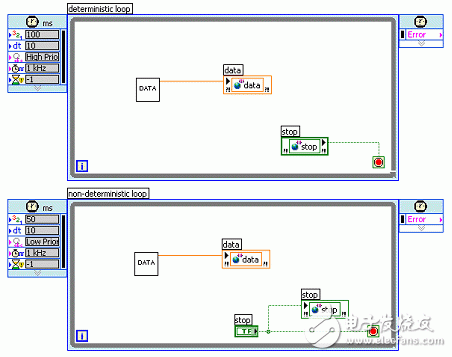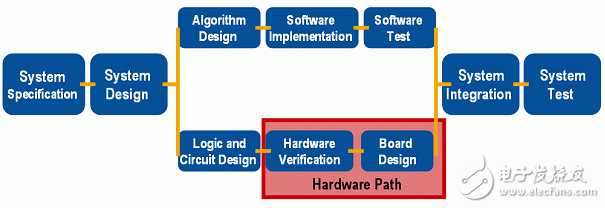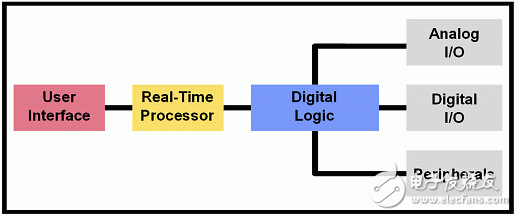Nearly 50% of the designs were delayed or unavailable; even after the launch, nearly 30% of the designs failed. The direct cause of many similar problems is that as the average code length has increased by nearly 10 times in the past 5 years, embedded systems have become increasingly complex. In addition, as embedded systems have become more popular, machine manufacturers, test engineers, control engineers, etc. Experts in the field all need embedded technology to develop systems, and they currently do not have the skills to develop embedded systems. With the increasing complexity of the system and the increasing number of non-embedded experts who need this technology, people urgently need a new embedded design method. Graphical system design revolutionizes design problems. It combines intuitive graphical programming and flexible commercial off-the-shelf (COTS) hardware to help engineers and scientists design, model, and deploy embedded systems more effectively. Through graphical system design, you can use a single environment at all stages of the design, thereby improving production efficiency, saving costs, and providing embedded technology to experts in various fields. Many embedded systems can run autonomously and need to process many tasks with special timing requirements in parallel. Suppose a machine control system is used to control a linear stage, rotate multiple axes, control lighting, and read video data; in such a system, multiple processes must be carried out in a definite, real-time, and parallel manner. If traditional and text-based tools such as C are used in such applications, the complexity will increase immediately. Instead, LabVIEW can use its own functions to easily develop complex programming and timing models. As early as more than 20 years ago, NI created components and technologies in the form of a LabVIEW graphical development environment. LabVIEW realizes timing through the coding structure, which perfectly integrates timing into the code; if you want to express parallelism, you only need to drag it into another loop as shown in Figure 1. Figure 1. LabVIEW's parallel timed loop visually shows parallel tasks The text code makes it difficult for many experts in various fields to achieve this level of timing and parallelism; while the graphical representation is clearer and more accessible to scientists and engineers. If the LabVIEW example is expanded to include FPGA and microprocessor chips, you will find that LabVIEW can easily manage the parallel architecture of silicon chips with the same consistency and scalability. Another key requirement of embedded system design is that the software platform should be used to browse various algorithms commonly used in real-time embedded design. As the research leader of embedded software platform at the University of California in Berkeley, Dr. Edward Lee regards design browsing as a computing model. These calculation models match the way the system designer browses the system, minimizing the complexity of converting system requirements into software design. In the past few years, LabVIEW has been extensibly incorporated into a variety of computing models to better meet the needs of embedded system designers and their various technical devices. LabVIEW now includes text-based mathematics, continuous-time simulation, state diagrams, and graphical data flow modes to represent various algorithms. LabVIEW also includes interactive tools to advance the design experience of digital filters, control models, and digital signal processing algorithms, making the design of such vertical applications easier. Now, we will wait and see how you can implement these algorithms on the flexible COTS hardware platform and greatly reduce the time to first modeling. As mentioned earlier, because many designs are delayed or not available at all, or even worse; because designs will fail after launch, we must take action to ensure that better products are obtained in a shorter time. One way to kill two birds with one stone is to better model the system by integrating actual signals and actual hardware into the design faster, so as to achieve iterations of high-quality designs and to find (and solve) problems earlier. As shown in the design process in Figure 2, the LabVIEW FPGA module can download LabVIEW designs to NI FPGA hardware; LabVIEW has been able to combine algorithm design and logic design through this module. Now we can concentrate on exploring the efficiency and means of shortening the hardware path. Figure 2. Typical embedded system software and hardware design process reflecting the independent design process of software and hardware Currently, if you are creating custom hardware for the final deployment, it is difficult to develop software and hardware in parallel. Because the software can only be tested on the actual hardware when it enters the system integration stage. In addition, you don't want to conduct purely theoretical software development; incorporating I/O in the system integration test phase and passing the actual signal test design may cause: it is too late when problems are found, and the design cannot be completed on time. Many designers currently use test boards to model the system. However, such boards often include only a few analog and digital I/O channels, and rarely include vision, motion, or synchronous I/O capabilities. In addition, designers often have to waste time developing custom boards for sensors or specific I/O just to prove the concept. As shown in Figure 3, through the flexible COTS modeling platform, you can really simplify the process and save a lot of work with hardware verification and board design. Nowadays, anyone can step into the electronic store, plug in components such as memory, motherboard, peripherals, and create a PC; the graphical system design is very similar to the PC, and strive to achieve the same standard modeling platform. Figure 3. Graphical system design pipeline development process For many systems, the modeling platform must incorporate the same components as the final released system. These components are usually: real-time processors used to execute certain algorithms, programmable digital logic used for high-speed processing or to connect real-time processors to other components, and various I/Os and peripherals [Figure 4]. Finally, if the best-selling I/O cannot meet all your needs when used in conjunction with various systems, the platform should be able to be expanded and customized when needed. Figure 4. Typical components of an embedded system National Instruments provides several types of modeling platforms, including NI CompactRIO. The platform contains all the basic modules of an embedded system. The control contains a 32-bit processor running a real-time operating system. The FPGA contained in the CompactRIO backplane can perform high-speed processing, and configure and provide actual interfaces for I/O modules that include analog input and output, digital input and output, and counter/timer functions. Each module includes: direct connection with sensors and exciters, and built-in signal conditioning and isolation. At the same time, the included module development kit allows developers to extend the platform and include custom modules-all plugged into the COTS architecture. In addition, CompactRIO adopts industrialized package (-40 ºC to 70 ºC, 50G anti-vibration), small footprint (3.5 inches x 3.5 inches x 7.1 inches), and low power supply requirements (typically 7W to 10W), which makes it not only very suitable It is suitable for modeling and is very suitable for the deployment of on-board, machine control and on-board predictive maintenance applications. As mentioned earlier, due to advantages in packaging, durability, and cost, CompactRIO is often used for modeling and deployment. However, users sometimes choose smaller custom board designs due to specifications or power supply factors. To meet this requirement, designers can deploy the code on any 32-bit processor through the LabVIEW embedded development module, thereby saving software purchase costs. The LabVIEW embedded development module combines all the above-mentioned advantages of graphical development, as well as ready-made analysis functions, integrated I/O and interactive graphical debugging. This module can take any 32-bit microprocessor as an object; the framework provided by it can openly integrate various current C-based third-party tool chains and operating systems, so as to customize the board design As an object. Once integrated, users can achieve 100% graphical development and interactively debug their applications. By integrating the generated code with all targets currently on the market, users can achieve the most target functions with the most flexibility. This new technology enables more and more scientists, engineers and experts in various fields to design algorithms, develop applications, programming logic, modeling systems and deploy systems to designated objects more conveniently. A new method of electronic system design has now been born. Graphical system design brings a software platform combined with a hardware platform, which can greatly reduce development costs and time to market. The software platform that integrates multiple computing models minimizes the time to implement project indicators into specific designs. The flexible COTS hardware modeling platform can support the software platform and provide custom components. By reducing the design time and design cost of custom hardware, the first modeling time is minimized. In addition, the actual I/O modeling ensures a better design-reducing current design errors. Finally, because the graphical software is consistent from design to platform modeling to the final target deployment, the code utilization is maximized and the transition to final deployment is simple and easy. With LabVIEW, you can design, model, and deploy embedded systems through a single graphical platform.
We are professional audio manufacturing company that makes a variety of speaker with bluetooth, including bluetooth portable speaker, bluetooth speakers outdoor, small speaker bluetooth, light bluetooth speakers, waterproof speakers etc.
With full turnkey service from product design to delivery, and every step in between.
From sophisticated custom audio systems to 'off-the-shelf' speaker drivers, iTopnoo has been saving our customers time, effort, and money.
To constantly offer clients more innovative products and better services is our consistent pursuit.
Best Portable Speakers,customizable bluetooth speaker, Custom jbl speakers, speaker wholesalers TOPNOTCH INTERNATIONAL GROUP LIMITED , https://www.mic11.com

